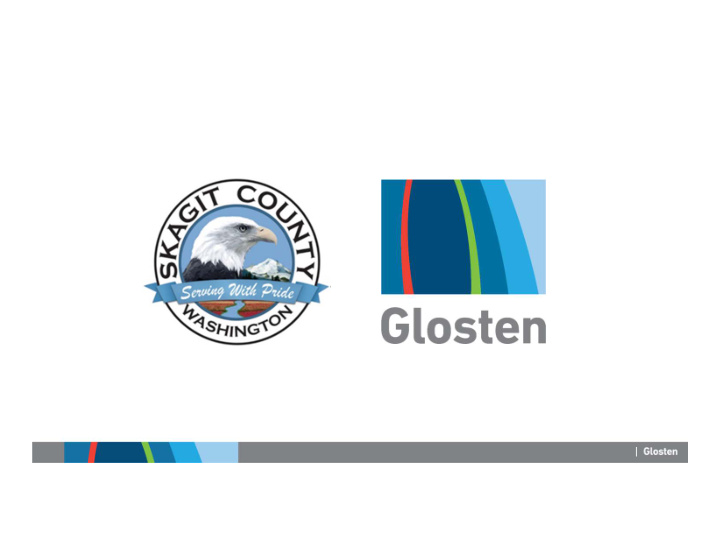



INTRODUCTION SCHEDULE TRANSPORTATION SYSTEM ASSESSMENT VESSEL CAPACITY STUDY CONCEPT DESIGN Q&A 2
INTRODUCTION SCHEDULE TRANSPORTATION SYSTEM ASSESSMENT VESSEL CAPACITY STUDY CONCEPT DESIGN Q&A 3
DESIGN TEAM 4
INTRODUCTION SCHEDULE TRANSPORTATION SYSTEM ASSESSMENT VESSEL CAPACITY STUDY CONCEPT DESIGN Q&A 5
NEAR-TERM SCHEDULE 6
LONG-TERM SCHEDULE 7
INTRODUCTION SCHEDULE TRANSPORTATION SYSTEM ASSESSMENT VESSEL CAPACITY STUDY CONCEPT DESIGN Q&A 8
OPTIONS & ALTERNATIVES Look at whole Transportation System Single vs. Double ended Monohull vs. Catamaran Steel vs. Aluminum • Steel hull for strength, exploring AL deckhouse for weight savings One vs. Two Ferries • Benefits to both systems • Total lifecycle cost evaluated for both options • 50% greater cost for a two ferry system 9
TERMINALS PND Engineers • Completed survey and preparing report • Apron widening – Needed to allow concurrent passenger and vehicle loading • Evaluating suitability of existing dolphins DN Traffic Consultants • Completed survey conducting analysis • Evaluating queuing and parking • Exploring ticketing options 10
THROUGHPUT ASSESSMENT Assumptions: How big can the new vessel be? • 2 roundtrips per hour 12. Remaining (0:20) 11. Unload³ (3:32) 1. Load¹ (5:07) • Full load in both directions • Ticketing bottleneck removed Start 10. Arrive (2:35) 2. Depart (2:27) Anacortes 9. Cruise (1:10) Findings: 3. Cruise (1:10) • Ramp clearing consumes time GuemesIsland 8. Depart (2:27) • Concurrent vehicle / walk-on loading 4. Arrive (2:35) needed 5. Unload (3:08) • 33 vehicle limit to meet 2 7. Load (4:42) 6. Turnaround² (0:47) roundtrips per hour M/V Guemes operation 11
EMERGENCY & ENVIRONMENTAL Emergency response scenarios developed • Range from MOB to marine evacuation with grid failure • Each propulsion system evaluated against scenarios Airborne noise Wake wash Permitting 12
INTRODUCTION SCHEDULE TRANSPORTATION SYSTEM ASSESSMENT VESSEL CAPACITY STUDY CONCEPT DESIGN Q&A 13
RIDERSHIP HISTORY Ridership data from 1980 to present • Detailed data starts in 2001 • 1% of trips contain a full load of walk-on passengers • 22% of trips contain a full load of vehicles (19 or more) • 2002 had the highest vehicle traffic 40 year design life used for replacement 14
PASSENGERS 15
VEHICLES 16
PASSENGER FORECAST • Forecast model considered Dwelling units, Population, Fares, Housing market, Unemployment, Parking, Schedule, Weather • Passenger ridership forecasted to increase 77% 17
VEHICLE FORECAST • Forecast model considered Dwelling units, Population, Fares, Housing market, Unemployment, Parking, Schedule, Weather • Vehicle ridership forecasted to increase 74% 18
VEHICLE FORECAST • Forecast model considered Dwelling units, Population, Fares, Housing market, Unemployment, Parking, Schedule, Weather • Vehicle ridership forecasted to increase 74% over 2016 levels 19
INTRODUCTION SCHEDULE TRANSPORTATION SYSTEM ASSESSMENT VESSEL CAPACITY STUDY CONCEPT DESIGN Q&A 20
DESIGN & REGULATORY REQUIREMENTS Terminal interface Operating environment Passenger and vehicle count Noise, speed, maneuvering RAM – no backup vessel USCG • Lifesaving and Stability • Manning • Batteries and Tonnage ADA • Passenger Vessel Guide EPA • Engine exhaust 21
PROPULSION SYSTEM STUDY Five propulsion options • Geared Diesel (baseline) • Diesel Electric • Series Hybrid • All-Electric • Plug-in Hybrid Operational profile is key Shore power infrastructure • Charging Anacortes only • Considering shore side batteries 22
PROPULSION SYSTEM STUDY Sensitivity analysis Lifecycle cost • Propulsion system only • 40 year design life • Includes battery and engine replacements Scoring system with owner-chosen weighting factors • Capex, Opex, emissions, reliability, etc. Staying with Z-drive technology 23
DESIGN PARTICULARS 32 Vehicles, 150 Passengers Deckhouse to the West • Complete vehicle and passenger segregation Steel hull • Lightweight but robust framing Considering AL deckhouse 2 x Z or L drive thrusters • Removable through main deck 24
CLOSING COMMENTS / Q&A William L. Moon, PE Project Manager wlmoon@glosten.com 206.624.7850 PROPRIETARY INFORMATION 25 PRESENTATION TITLE
Recommend
More recommend